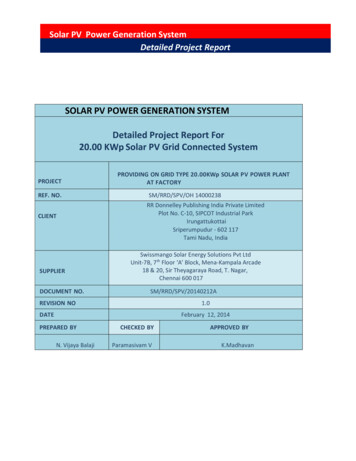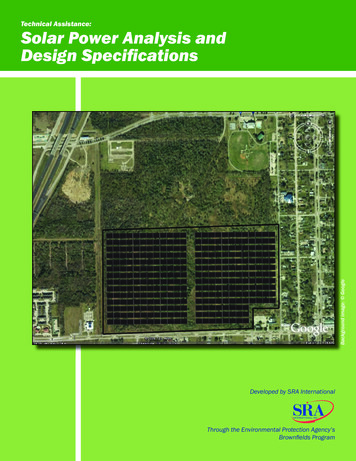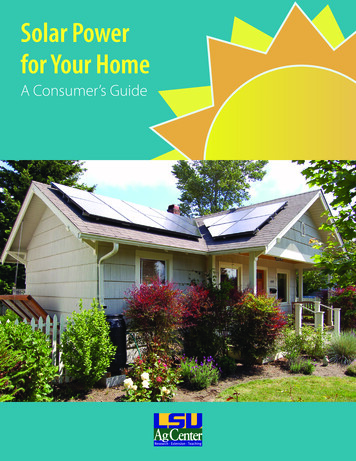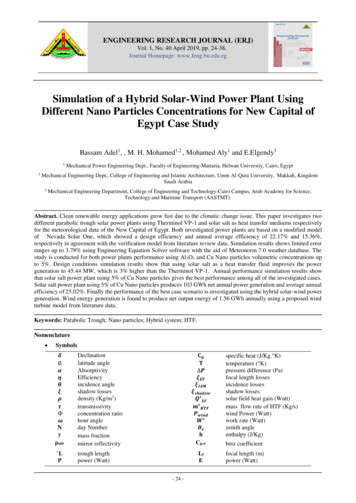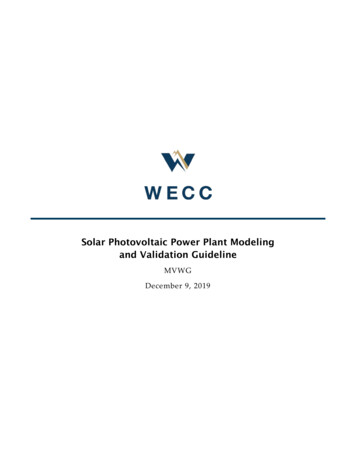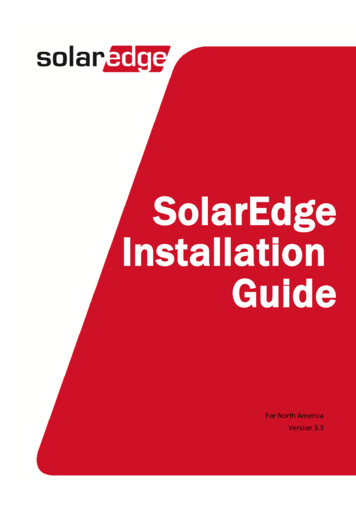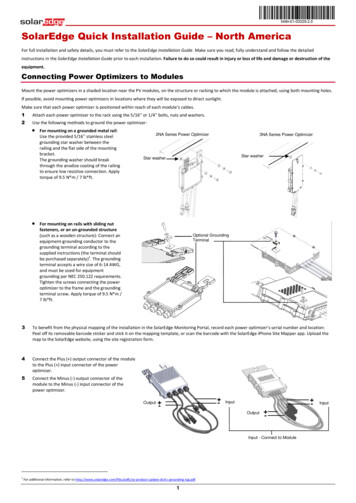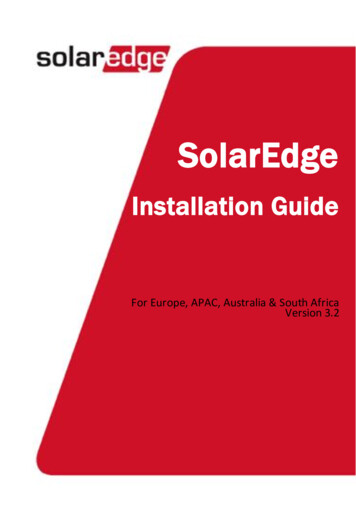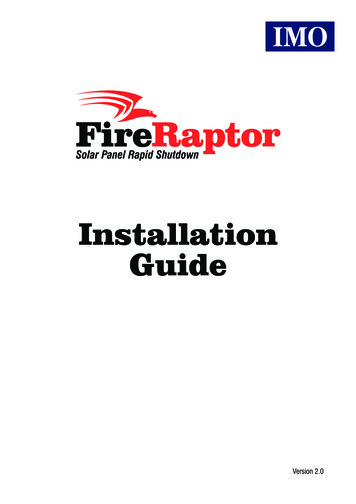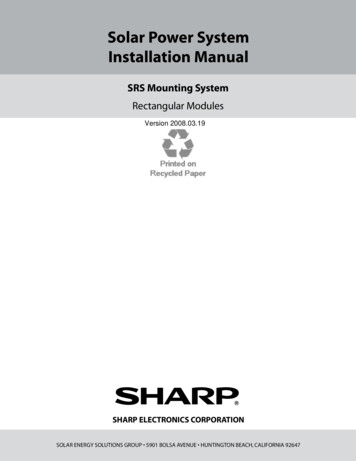
Transcription
Solar Power SystemInstallation ManualSRS Mounting SystemRectangular ModulesVersion 2008.03.19SHARP ELECTRONICS CORPORATIONSOLAR ENERGY SOLUTIONS GROUP 5901 BOLSA AVENUE HUNTINGTON BEACH, CALIFORNIA 92647
F or installation personnel Please read this manual carefully before installing the system and carry out the installationprocedures correctly. This manual does not list all precautions needed for safe work. Be sure to follow OSHA guidelines. This manual provides guidelines for installation, but it does not guarantee the quality of installationwork. Please complete all work in a responsible and professional manner. Electrical work shouldbe performed by a qualified electrician.The SRS mounting system has been load tested and verified by a ProfessionalEngineer. This information can be provided upon request.
TAB L E O F CO N T E N TS6For Installation Personnel 2Installation Work 21-44Table of contents 36.1 Preparing shingle rooffor installation. 21For Safe Installation Work 4-96.2 Checking layout. 221.1 Cautions regarding installation ofsolar power systems.66.3 Installing the optional flashings . 2316.4 Installing standard slider assembly. 241.2 SRS Mounting System.7-86.5 Preparing tile roof installation. 251.3 PV modules.8-96.6 Checking layout. 262 Points to Check when Selecting theInstallation Location 9-126.7 Installing tile slider assembly.27-306.8 System grounding . 312.1 Condition of house where solar powersystem is to be installed. 9-106.9 Installing module support rails. 322.2 Checking the solar power systeminstallation location.11-126.10 Installing front cover. 336.11 Installing the modules onthe SRS mounting system.34-353 Specifications 13-146.12 Installing top cover.35-363.1 Solar module and array specificationsmodules: ND-167U1Y / ND-187U1 /ND-187U1F. 136.13 Installing side cover. 366.14 Connecting the solar modules.36-383.2 ND-167U1Y / ND-187u1 / ND-187U1Fmodule array layout dimensions. 144Parts 15-195Points to Check Before InstallationWork 19-206.15 Testing module strings for correctvoltage . 39LIMITED WARRANTY Back cover
1For Safe I nstallation WorkThis system shall be installed only by individuals who have completed the SRS training course established bySharp Electronics Corporation. Please visit our website http://solar.sharpusa.com to learn about Sharp training. Call usat 1-800-solar06 to find a certified installer in your area.Safety iconsVarious safety icons appear in this installation manual and on the products it describes. These icons are categorized in thefollowing manner, according to the consequences of ignoring the icons and handling the products inappropriately.Make sure that you understand these icons and always read the accompanying text.WARNING This indicates danger of death or serious bodily injury.CAUTIONThis indicates danger of bodily injury or damage to property.This icon indicates something you must never do.WARNING Do not cut or modify SRS Mounting System. Doing so is dangerous. Safety cannot be guaranteed. Stop work during stormy weather. Strong winds can cause you to fall or drop the solar modules.CAUTION Never step or sit on the glass surface of a solar module. The glass may break, resulting in shock or bodily injury. Themodule may also stop generating power. Always use the supplied parts to attach the solar modules and mounts.Use of weaker parts, such as screws that are too short, is dangerous and may cause the solar modules or mountsto fall. Always use the specified tools.The solar modules or mounts may fall if the installation is not strong enough, for example when parts are nottightened sufficiently. Regardless of whether you are working on a new or existing roof, never allow the sheathing to become wet. Protectthe sheathing from rain during the installation. Failure to do so may cause leaks. Always use the specified materials.Use of other materials is dangerous. Materials other than specified can reduce performance and can cause leaks,shock, and so on. Do not modify or cut parts. Do not install the system in a location within 0.3 miles from the ocean or any salt water. Do not install in corrosive locations classified C5 by ISO. The SRS mounting system and modules are UL listed to standard 1703. The UL 1703 test is performed at 1.5 times thedesign load of 30 lbs per square foot, or 45 PSF. The SRS mounting system has been load tested by Sharp to 50 PSF. Donot use in locations subject to higher loads. Building departments often require a design safety factor of 1.5 or greaterfor structures. The maximum structural loading listed in this guide does not include an added safety factor. Protective earth grounding of the individual photovoltaic modules is achieved by securing the modules to the SRS mountingsystem. TheGrounding instructionsinstructions inin sectionsection 6.8 should be closely followed, in order to ensure a reliableThe SingleRail toPointRail Groundingground connection. The SRS mounting system has only been evaluated by UL for use with the photovoltaic modules listed in this manual.
1For Safe I nstallation WorkUL Required Information:1. Artificially concentrated sunlight shall not be directed on the module.2. “Rated electrical characteristics are within 10 percent of measured values at Standard Test Conditions of: 1000 W/m2,25 C cell temperature and solar spectral irradiance per ASTM E 892 or irradiation of AM 1.5 spectrum.”3. Under normal conditions, a photovoltaic module may experience conditions that produce more current and/orvoltage than reported at Standard Test Conditions. Accordingly, the values of ISC and VOC marked on UL Listedmodules should be multiplied by a factor of 1.25 when determining component voltage ratings, conductor capacities,fuse sizes and size of controls connected to the module output. Refer to Section 690-8 of the National Electric Codefor an additional multiplying factor of 1.25 which may be applicable.4. Wiring methods should be in accordance with the NEC.5. Install wires and cables with appropriate hardware in accordance with applicable electrical codes.6. Protective earth grounding of the individual photovoltaic modules is achieved by securing the modules to themounting frames. The assembly instructions should be closely followed, in order to ensure a reliable groundconnection.7. The framing system shall be grounded in accordance with NEC Article 250.8. #10 AWG copper wire is the minimum size acceptable for the primary protective ground connection to the rails.9. A UL Listed Grounding terminal constructed of tin-plated copper or stainless steel, or steel provided with a zinc orberyllium coating, and suitable for outdoor use, shall be used with the selected grounding wire (minimum 10 AWGcopper wire).10. All of the Rails in an installation shall be provided with protective earth bonding wires when installed.11. The framing system has only been evaluated by UL for use with the photovoltaic modules listed in this manual.
1For Safe Installation Work1.1 Cautions regarding installation of solar power systemsThis manual contains critical information regardingelectrical and mechanical installation and safetyinformation which you should know before startinginstallation.3 Do not stand or step on solar module.4 Do not install near flammable gases.5 Do not drop or allow objects to fall onto module.6 Completely cover solar module with opaque materialsThe information in this manual is based on Sharp’sknowledge and experience, however, the informationand suggestions do not constitute a warranty.when wiring to halt production of electricity.7 Keep the back side of solar module surfaces free offoreign objects.Sharp Electronics Corporation reserves the right to makechanges to the product, specifications, or manual withoutprior notice.8 Do not use chemicals on solar modules whencleaning.9 Do not wear metallic jewelry, which may causeDo not locate systems near coastal locations or othersalt water locations or C5 locations as classified by ISO.Minimum distance is 0.3 miles from the body of water.Do not locate in a corrosion prone area. The modulesand system are UL listed to standard 1703. The UL 1703test is performed at 1.5 times the design load of 30 lbsper square foot, or 45 lbs per square foot. The system hasbeen load tested by Sharp to 50 PSF. Building departmentsoften require a design safety factor of 1.5 or greater forstructures. The maximum structural loading listed in thisguide does not include an added safety factor. Check withyour local building department for code information.electrical shock.10 Do not touch cable electrical contacts.11 Do not expose solar modules to sunlight that isconcentrated with mirrors, lenses or similar means.12 Consult local codes and other applicable laws andstatutes concerning required permits and regulationsconcerning installation and inspection requirements.Install solar modules and systems according toapplicable codes.13 Solar modules should be installed and maintained byqualified personnel. Keep unauthorized personnelaway from solar modules.CAUTION14 Avoid shadowing cells in order to prevent solar1 Do not drill holes in frame.module hot spots and/or reduction in power.Do not cut or modify parts or rails.15 Avoid installing modules and mounting system in2 Work under dry conditions with dry tools. high corrosion areas. Cover solar module during installation to reduce shock hazard Keep foreign objects away from solar module surface
1For Safe I nstallation Work1.2 SRS MOUNTING SYSTEMWARNING Always follow OSHA guidelines.Solar modules are installed on rooftops where there isdanger of personnel falling off of the roof. Scaffolding,stepladders, and ladders may be dangerous and requirecaution. The installation of solar modules involves workin high places; take extreme precautions to avoid fallingfrom roof. To prevent accidents, safety regulations mustbe observed. Always take the following precautions toprevent accidents and injury.1 Take the following precautions before starting work. Plan the job and visit the site before starting work. On site, do not work alone. Always work with atleast one other person. Inspect power tools before using them. Choose a safe spot to anchor ladders andstepladders. Always work with a partner. One person shouldhold the ladder steady. Ladders from a first-story roof to a second-storyroof are very dangerous. Do not set up a ladderon a roof. When there is no other choice, straddlethe ridge and lay down a rubber anchor mat, andsecure the ladder to the mat. Always have oneperson hold the ladder firmly. When you use a two-stage ladder, secure it withropes or stays to prevent it from sliding sideways,and have two people hold the ladder steady. Use ladders with steps broad enough to permitsafe work.5 When working in high places, wear harnesses anduse scaffolding.2 When conditions make it necessary, tell workersto stop working. When working at heights of 6 feet or more, usescaffolds or other equipment to ensure a stablework platform.Immediately after rain, and when work areas areslippery. Scaffolds should be designed and erected by aqualified person. When high wind conditions exist, or are expected,or when a high wind warning has been issued. When it is snowing, or when there is snowunderfoot.When it is difficult to erect a stable work platform,install safety nets, wear harnesses, and take othermeasures to prevent falls. Regulations mandate the use of harnesses. Fastenharnesses securely, and check that the length oflifelines is 6 feet or less. Attach the primary support line securely to ametal fixture installed for that purpose on a ridgeor beam. When it is raining, or there is a strong probabilitythat it will start raining. When the condition of the scaffolding and laddersis not satisfactory.3 Wear appropriate work clothes and protectiveequipment. Work clothes for both the upper and lower bodyshould fit well and allow you to move freely. Always wear protective equipment such asharnesses and lifelines. Wear a helmet and secure it correctly. Wear non-slip shoes. Shoes get dirty when wornon a roof, so keep the soles clean.6 Install enclosures and covers.4 Observe safety regulations for ascending anddescending ladders and stepladders. Before use, always inspect ladders and stepladdersto makes sure they are in good condition. Install enclosures, guardrails, or covers at the end ofwork decks that are 10 feet or more above ground,at openings, and at other dangerous locations. When it is extremely difficult to install enclosures,guardrails, or covers, or when they must beremoved to work in that location, install a safetynet, wear harnesses, and take other measures toprevent falls.
1For Safe I nstallation Work7 Protect against falling objects.8 Other When objects are thrown down from a height of6 ft or more, appoint a surveillance person on theground and warn others about falling objects. When there are electric power lines near the roofor eaves, request the power utility to take advancemeasures to prevent shock. Do not allow third parties to enter the work areaduring construction. Check the health of workers before starting work. Arrange tools and materials neatly and securethem with ropes, or use bags or other measures toprevent falling objects.Lift packaged modules by grasping both sides ofthe package. Do not lift by grasping the band, asthe band can break. Never step or sit on the glass surface of a solarmodule. Ensure the module connectors are fully inserted.There is a risk of malfunction if they are not pushedin all the way. Support output cables so that there is no slack.High winds can blow slack cable against the rail,damaging the cables.1.3 PV ModulesWARNING Wiring work should be performedaccording to the provisions of the National ElectricalCode. Grounding work and wiring connections tothe inverter should be performed by a qualifiedelectrician.Adhere to all of the NEC. Pay special attention toArticle 110, Chapter 2 , Article 250, Chapter 3, Articles300 & 310, 480 & 690.3 Wiring from solar arrays to the inverter (connectorbox).The solar array generates electricity whenever it isexposed to sunlight. Be careful when handling it. There isa danger of shock if you touch the connectors or wires ofthe electric cables. Follow the provisions of the National ElectricalCode. Adhere to all of the NEC. Pay specialattention to Article 110, Chapter 2, Article 250,Chapter 3, Articles 300 & 310, 480 & 690. For wiring through walls, protect the cables withmetal conduits, flexible metal conduits, or otherprotection. Failure to do so can result in shockand short circuits. Always use conduit to protectsections of array output cables that are exposedto sunlight.1 Points to check before wiring. The solar modules generate electricity whenexposed to light. You will need to wear insulatinggloves. You will need a multimeter for volts, amps,resistance and continuity capable of measuringDC and AC up to 600 Volts and 40 Amps. Make sure your tools are insulated.For wiring outdoors, protect cables with PVCconduits, metal conduits or flexible conduits.2 Wiring the solar modules. Never step or sit on the glass surface of the solarmodules. The glass may break. When you install the solar modules on the rail, neverallow an output cable to become caught betweenthe rail and a module frame. The solar modules generate electricity whenexposed to sunlight, take care not to short circuitthe output cables. The cables can becomeoverheated and their cable sheaths can melt. Prevent water from entering or building up inconduit by using waterproof fittings or duct seal. To prevent shock, tape and label the cut ends ofarray output extension cables (the side oppositeto the connector side) before connecting to solarmodule output cables. Further, tape them againafter measuring the voltage of each array. To prevent shock when you connect the arrayoutput cables to the inverter, remove the tape onecable at a time as you connect the cables.
1For Safe I nstallation Work4 Measuring array output voltage5 Grounding the mount See the description of how to measure the outputvoltage for each array. To prevent shock, always connect a ground wirefrom the SRS mounting system to earth. Make sure that all solar modules are exposed tosunlight. (Remove lightproof sheets, if present.) Use a minimum #10 AWG ground wire. Follow NEC 690 grounding provisions. Set the volt meter measurement range to a DCvoltage, greater than the expected measurement(for example 600 VDC). Keep the plus ( ) solar array output cables awayfrom the ends of the minus (-) cables. Dangerousarcs can occur. (The array output voltage undernormal conditions (clear skies) can be very high.)2Points to Check when Selecting the Installation Location Check the following items before starting installation work. Refer to the inverter installation manual for more information about inverter installation and electrical work.2.1 Condition of house where solar power system is to be installedInspection of roof structureIt is important to inspect the structural integrity of theroof and the durability of the roof materials. The SRSmounting system and solar modules require a strong basefor durable and reliable operation in local environments.Always wear a safety harness when working on the roof.Inspection of the roof support systemThis may require access to the attic.Inspect the roof surface in the area of the installation forcracks, water leakage, and roofing material quality anduniformity. This is especially important if the roof is olderthan 10 years.Measure the spacing of the rafters or trusses to confirmthe dimensions and prepare for the system layout.Check that all rafters, trusses and other materials are ingood condition.Check for indication of previous water leaks.Determine the location of the electrical roof penetrationand wire run, if wiring is planned for this area.Inspect the roof for sags and other abnormalities. A sagor deep depression in the roof may indicate a structuralweakness in the support system that may requirecorrection. The following illustrations detail typical roofconstruction as well as old roof problems.
2Points to Check when Selecting the Installation LocationExample ROOF CONSTRUCTIONRidgeRoofing-feltAsphalt shinglesRakeFacia boardRoofing deckRaftersExamples of poor roof conditionDamagedshinglesBroken shinglesand sagging roof10
2Points to Check when Selecting the Installation Location2.2 Checking the solar power system installation locationCode Compliant installation1. Determine the wind loads for the installation site.Check with your local building and safety departmentfor the specific requirements.7. Reference the chart wind speeds to determine yourdesign wind pressure (psf). Determine exposurecategories A through D for various roof heights.8. Based on the loading
and suggestions do not constitute a warranty. Sharp Electronics Corporation reserves the right to make changes to the product, specifications, or manual without prior notice. Do not locate systems near coastal locations or other salt water locations or C5 locations as classified by ISO. Minimum distance is 0.3 miles from the body of water.
